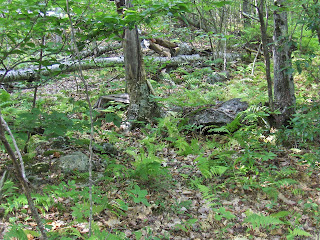I think the conclusion is that these sites are quite common and easy to find. But they are also easy to miss, so you have to look.
I blogged about this hill before [click here or here or here]. There are rock piles in several places. So much so, that I payed little attention to a small 'altar' I found somewhere between the main hill and the southernmost point of the above blue path, or to a third cluster when I was heading north at the end of the walk - these were adjacent to the main gully, so not really a new site.
I was having a conversation with Curt Hoffman and we discussed a principal question: why is a site located where it is? There are at least two kinds of answer: a site is located where there is some aspect of the natural landscape that is functionally useful to the site - for example a wetland, or a flat slope, as described above. Another possibility is that sites occur where it is convenient - for example along a road. We have discussed this before and I recall Larry Harrop saying his sites are usually a long way from roads and in the middle of nowhere.
Nevertheless, the sites I find north of Fitchburg are usually near a road or navigable brook. Some of the best ones are where a road crosses a brook. So, I propose that sites are located at the intersection of landscape and convenience.
For example, where should we look for rock piles here?
Back at Blood Hill I want to mention one stone wall that fits the "ravine culture" idea I was promoting earlier. This wall came up the hill, hooked around, and ended a few feet later, with a piece of quartz. Perhaps you can make it out in the photo, it is a little bit like the large "J" in the main gully of the hill.
The site at "b" was quite beaten down. It consisted of about 10 small decrepit piles. Some on support, some on the ground. Offhand, I would say this is the same kind of site as at "c" and at the place called "B" in the link about about "a slow climb". Here are some of the piles at this "b":
A hint of a vertical side.
Hard to say if there was any layout present. I took a few pictures then continued across the hill.
When I got to the west end of Whitney Rd I was a bit confused with the intersection of another old road there ("Breed Rd"?), and was heading north and east on it and stopped, thinking: nah there is nothing in that direction but a slow slope. I paused, unsure, not realizing I could go even more easterly. So I abandoned the slow slope in favor of turning west and hit rock piles immediately, at "c". These were better defined than the piles at "b". I want to say: teardrop shaped from above, with a piece of quartz, or burnt rock in them. Here is the scene:
And some of the piles:
closeup
closeup
Some of these are getting rather big.I take care to document these examples of piles with a corner or "point"; and with piece of quartz at the point. It happens exactly in this way at Patch Hill in Boxboro (have a look).
And here is one with a flat slab above a burnt rock:
closeup
And that is it.



















1 comment :
Interesting question: "Why are sites located where they are?" I've found that visually impressive natural features are often what drew the Native Americans to certain sites. That was the case with the Oley Hills site in PA, which focused on the large standing boulder on the hilltop. It looked like a glacial erratic, but it was actually a tor, since the last glacier ended its southern movement about twenty miles to the north. And because it apparently once rocked, attention focused on it. Every other bit of placed stone nearby (flat-topped and cone cairns, walls, etc.) seemed to reflect the significance of the large boulder. At other sites, it can be an impressive looking outcrop, a spring, stream. Or it may be something that we cannot quite comprehend. There are certainly quite a lot of sites like that.
Post a Comment